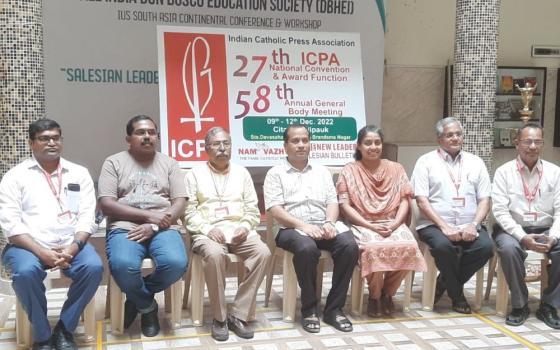Some Catholics who spend the winter in Florida report overflowing churches for weekend Masses. Does this indicate that the Catholic Church in the United States is a lot healthier than others have suggested?
A recent study produced by the Center for Applied Research in the Apostolate (CARA) at Georgetown University in Washington, D.C., says otherwise. (For an executive summary of the report, see Origins, "The Changing Face of U.S. Catholic Parishes," 8/18/11, pp. 194-5.)
The project, "Emerging Models of Pastoral Leadership," was funded by a Lilly Endowment grant to the Emerging Models Project. The project's five Catholic partner organizations are the National Association for Lay Ministry, the Conference for Pastoral Planning and Council Development, the National Association of Church Personnel Administrators, the National Catholic Young Adult Ministry Association, and the National Federation of Priests' Councils.
The principal result of the study is that more U.S. Catholics are attending Masses at fewer parishes staffed by a rapidly declining number of priests. CARA found that the number of Catholic parishes has declined by 1,359 since the year 2000 to 17,784 in 2010, representing a 7.1 percent decrease.
Unfortunately, although smaller parishes (200 households or less) are more likely to be closed or merged with larger parishes, there is a higher rate of Mass attendance at smaller parishes than at larger ones.
But the percentage of smaller parishes dropped from 24 percent in 2000 to 15 percent in 2010. Parishes with more than 1,200 registered households now make up 33 percent of all parishes.
It is of special interest that 40 percent of all growth in registered parishioners in U.S. parishes from 2005 to 2010 occurred among Hispanics/Latino(a)s. In fact, almost one in three parishes celebrates Mass at least once a month in a language other than English. Of these, 81 percent is in Spanish.
The average number of Mass attendees at weekend Masses in October was 1,110, or 38 percent of registered parishioners. This number represented 47 percent of parish capacity (number of Masses multiplied by seating capacity).
On average, however, respondents indicated that the proportion of parishioners who are non-Hispanic white has decreased in the last five years as Catholics of other races and ethnic backgrounds make up a larger portion of registered parishioners.
As far as finances are concerned, 30 percent of parishes indicate that their expenses exceeded their revenue. Of those parishes reporting a deficit, the average size of the shortfall was 15.8 percent of revenue.
Smaller parishes generally collect more per registered household in the offertory collection than larger parishes. But it is the smaller parishes that are being closed or merged with larger ones, and it is the larger, standing-room-only parishes that give some Catholics the wrong impression that all is well with the Catholic Church in the United States.
The closing or merging of smaller parishes with larger ones is a relatively recent development, beginning sometime after 2004.
As far as programs and ministries are concerned, parishes are most likely to meet pastoral needs for sacramental preparation and religious education, and for the sick and homebound (86 percent). Majorities have youth ministry (76 percent), ministry to seniors (64 percent), social services to meet individual needs (59 percent), and ministry to the bereaved (54 percent).
Staffing of parishes yields some of the most compelling data. The estimated number of lay ecclesial ministers (that is, those who are paid and who work at least 20 hours per week) is approximately 38,000, or 2.1 percent per parish. Fourteen percent of these are vowed religious, while 86 percent are laypersons.
Overall, 80 percent are female–a statistic that has remained steady for many years and which makes the continued alienation of Catholic women a serious and growing pastoral problem.
Parish staffs (including bookkeepers, janitors, and cooks) also consist of large numbers of women (52 percent). One in four members of the ministry staff is a diocesan priest.
It is of much significance that parish staff members and lay ecclesial ministers consist of an aging population. Fifty-six percent are between the ages of 50 and 69. Fifty-five percent of ministry staff, including priests, are also between these ages.
That is why this study is so important. As noted at the outset, more U.S. Catholics are attending Masses at fewer parishes staffed by a rapidly declining number of priests.
The rosy impression that some vacationing Catholics have of the health of the Catholic Church in the United States is simply wrong.
[An earlier version of this story incorrectly stated the recipient of the Lilly Endowment grant: the Emerging Models Project, not CARA, received the grant. CARA was contracted to conduct the research.]
© 2011 Richard P. McBrien. All rights reserved. Fr. McBrien is the Crowley-O'Brien Professor of Theology at the University of Notre Dame.
To read NCR stories related to this CARA study, please see:
Study finds US Catholic parishes growing larger, more complex
The megaparish: more boon than bane
US Catholic parishes growing in size and diversity
A complete copy of the CARA study is available here: www.emergingmodels.org/article.cfm?id=75




